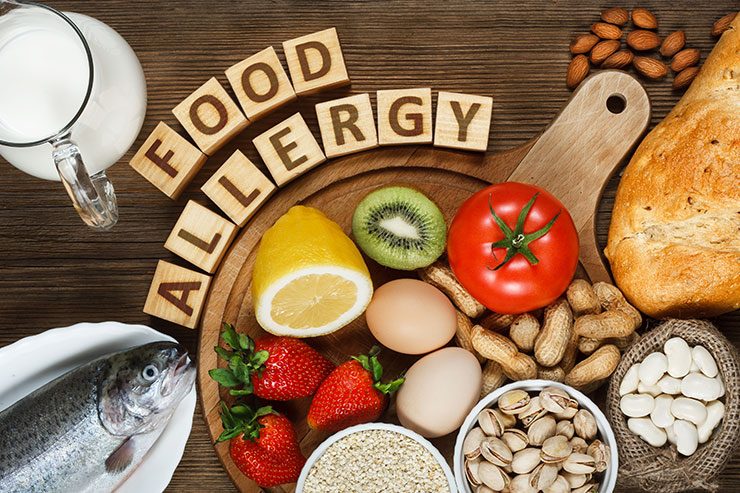Food Allergies — What Could I Be Allergic To?
Are you dealing with food allergies? We know how daunting it can be to deal with this situation as the effects can be quite embarrassing or potentially deadly. The thing is, there’s no cure for this problem, so the best advice for anyone with a food allergy is to consciously avoid the foods that trigger the reaction. For the most part, anyone with a food allergy can react to any food substance. Some of the most common food allergies include tree nut allergy, peanut allergy, egg allergy, milk allergy, fish allergy, sesame allergy and soy allergy. The list goes on and on, there are even people who suffer from alcohol allergy and the like.
Symptoms of Food Allergy’s
For starters, food allergy symptoms typically appear within minutes or hours after coming in contact with or eating the food you’re allergic to. These symptoms are normally classifieds as classic allergy which could be skin reactions, gut reactions, and respiratory reactions. Here are some of the common symptoms to look out for:
Skin Reactions
- Itching
- swelling
- Redness
- Eczema
Gut Reactions
- Vomiting
- Abdominal pain
- Diarrhoea
Respiratory Reactions
- Sneezing
- Runny nose
- Cough
- Wheeze

Top 14 Allergens in the UK
As we know, the allergy epidemic is growing in the UK — the numbers of sufferers keep increasing by 5% each year. With quite a number of hospital admission allergies in England and cases of life-threatening anaphylactic shock, the epidemic is not something to be ignored.
In response to this unfavourable trend, EU legislation now requires restaurants and supermarkets to highlight the top 14 allergens either on food menus or product labels.
Here they are:
- Crustaceans such as cray fish, crabs, prawns, etc.
- Cereals containing gluten
- Celery
- Egg
- Fish
- Lupin
- Milk
- Mustard
- Mollusc
- Nuts
- Peanuts
- Sesame seeds
- Soya
- Sulphur dioxide
What is the Difference Between Food Allergy and Intolerance
Food allergy is an immune system response to a particular food which eventually triggers an allergic reaction. Food allergy is a bit rare and typically causes symptoms minutes after eating the offending food. In this case, the immune system sees the food as an invader.
On the other hand, food intolerance is a severe reaction to food, but it has nothing to do with the immune system. Intolerance happens to be a lot more common, and the symptoms can be delayed by many hours (even as long as 20 hours or more) after eating a particular food. Some of the most common food intolerances include:
- Lactose intolerance
- Gluten intolerance
- Histamine intolerance
Lactose Intolerance
Lactose intolerance comes as a result of the inability to digest milk sugar due to low levels of the enzyme lactase. For the most part, lactose is a type of sugar that’s primarily found in milk and dairy products. Most people tend to confuse lactose intolerance with milk allergy, but it’s important to note that it’s not an allergy.
Symptoms
The symptoms of lactose intolerance typically develop after a few hours of consuming food or drink that contains the sugar. The main symptoms of lactose intolerance include:
- Flatulence
- Bloating
- Diarrhoea
- Infantile colic
- Abdominal discomfort
Note: Lactose intolerance may also cause nausea and constipation.
How to Treat Lactose Intolerance
Most people can manage lactose intolerance by limiting the amount of lactose in their diet. This means that some people including adults and children may not react to small amounts of lactose in foods. It’s important to note that lactose can serve as a prebiotic. This means that it can help feed healthy gut bacteria and enhance absorption of minerals — so it’s great to get a little lactose if you can.

Gluten Intolerance
Gluten is typically known as an “antinutrient” and as such, is hard to digest for nearly all people regardless of whether they’re gluten intolerant or otherwise. For the most part, there has been a series of controversy over its existence as well as whether it’s triggered by gluten or some other protein found in wheat. Moreover, we’re still trying to figure out if the condition has a link to the immune system or just an intolerance.
Symptoms
There are quite a number of symptoms associated with the consumption of wheat. Some of them include:
- Altered bowel habit
- Abdominal pain
- Bloating
- Nausea
- Acid reflux
It’s also important to note that gluten intolerance is linked to other symptoms outside the digestive system including:
- Anxiety
- Depression
- Foggy mind
- Fatigue
- Headaches
- Weight loss
- Overall lack of well-being
How to Treat Gluten Intolerance
At the moment, gluten intolerances are extremely difficult to ascertain. The diagnosis is carried out by excluding wheat allergy and coeliac disease. One of the most common ways to find out if a person has gluten intolerance is an elimination diet. In other words, he or she will have to eliminate foods that contain gluten to see if the symptoms resolve. There will also be a reintroduction of gluten-containing foods to see if the symptoms reappear. It’s recommended for patients to see a specialist dietitian who can help them determine the appropriate dietary regime.
Histamine Intolerance
For the most part, Histamine, as well as phenyl ethylamine and tyramine, are vasoactive chemicals that are naturally found in certain foods. Histamine is actually a chemical that’s associated with your immune system, digestive system, and central nervous system. It’s also a component of stomach acid that supports the breakdown of food in your stomach.
Symptoms
For starters, Some people may not react to the amounts found in their regular diets. But there are those who experience symptoms to even normal levels of vasoactive chemicals — this may be caused by the inability to break them down in their guts. Here are some symptoms of histamine intolerance:
- Anxiety
- Abdominal cramps
- Flushing
- Fatigue
- Hives
- Hypertension
- Headaches
- Nausea and vomiting
Note: Symptoms are likely to occur thirty minutes or longer after coming in contact with or consuming the offending food. Moreover, the level of intolerance is not constant — it actually varies from individual to individual.
How to Treat Histamine Intolerance
After discovering the food allergy and other underlying causes, the surest way to determine if vasoactive amines are the culprits of histamine intolerance is to simply avoid them for about two to four weeks. It’s recommended to monitor symptoms, and you can do this by keeping a food and symptoms diary. Afterwards, you can start reintroducing the foods little by little, so you can see just how much can be tolerated.
How to Manage Food Allergies
Today, there are a plethora of tips on management and avoidance when it comes to dealing with food allergies but here are the four most important things to keep in mind:
- Determine the cause and avoid it if possible.
- Get a better idea of the symptoms of an allergic reaction by keeping a food diary.
- Try to learn or figure out what to do if it occurs again.
- Always carry your medication with you when eating out.




























